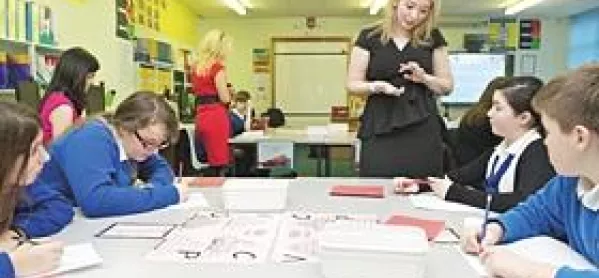Teaching hospital method examined and taken on

Next year all postgraduate trainee teachers at the University of Glasgow will carry out their practical placements in schools modelled on the teaching hospitals used to train medical students.
Traditionally, the university’s PGDE students have carried out three blocks of teaching practice at a variety of schools, with tutors parachuted in for a single “crit” lesson.
The new model - one of the proposals in the Donaldson report on teacher education - aims to get away from the one-off “crit” and replace it with something more akin to continual assessment, with students observing each other in the classroom during “learning rounds” and university tutors relocating to schools for the duration of student placements.
It is hoped the scheme will lead to deeper partnership working between schools and universities and avoid teachers and tutors clashing over student assessments. At the end of the placement, students will receive one joint report.
The concept was first piloted in Glasgow last year (see panel, right) when two University of Glasgow tutors shadowed 31 PGDE student teachers at Hillhead High, Notre Dame High and 11 local primaries in Glasgow’s west end.
Now the city’s King’s Park Secondary, Holyrood Secondary and four primaries will deliver the new-style placements, along with North Ayrshire’s Irvine Royal Academy and its five feeder primaries.
This year, roughly a third of the university’s PGDE students are experiencing the new placements. By the start of next academic year, the university plans to train every PGDE student in this way.
Ultimately, Glasgow City Council hopes all of its schools can become involved. To oversee the development and roll-out of the initiative, the position of teacher-education coordinator has been created and jointly funded by the council and Glasgow and Strathclyde universities, although the detail of Strathclyde’s involvement is still under discussion.
Professor James Conroy, the former dean of education at the University of Glasgow who has spearheaded the new approach, said: “This is a hugely exciting model of teacher education that we are convinced will lead to more robust and dynamic links between university and local schools. It’s a bit like the teaching hospitals where you have staff in school full-time, all day every day.”
However, Scotland’s largest teaching union, the Educational Institute of Scotland, has “significant reservations”.
Larry Flanagan, the incoming general secretary, experienced the new model of teacher training first-hand as principal teacher of English at Hillhead High.
Workloads increased under the new model, he said; tutors lacked subject expertise; and pupils were more likely to be taught by students, which could impact on their learning.
But Professor Graham Donaldson said: “This is a chance for the profession to create its own future. I hope the unions don’t oppose this on grounds that could be easily overcome.”
emma.seith@tess.co.uk.
LEARNING ROUNDS What happens at the beginning, middle and end of a lesson will be the focus of the first block of learning rounds undertaken by the 27 University of Glasgow trainee teachers currently on placement at Irvine Royal Academy in North Ayrshire and its associated primaries. Three students will observe one of their colleagues delivering the relevant segment of the lesson, along with a university tutor and one of the school’s teachers. The key point of learning rounds is that they are a non-evaluative and non-judgemental form of observation. Learning rounds were first used by Richard Elmore, a leading academic at the Harvard Graduate School of Education. They were adapted for Scotland by the National CPD team and the University of Edinburgh’s Scottish Centre for Studies in School Administration and trialled in seven local authorities. Irvine Royal was one of the pilot schools. GLASGOW PILOT A report into Scotland’s first teaching schools, which take their inspiration from teaching hospitals, found the scheme had created “many powerful learning experiences for students, teachers and tutors”. The report evaluated the impact of a Scottish government-backed scheme which saw two University of Glasgow tutors shadow 31 PGDE student teachers at two secondaries and 11 primaries in the city’s west end. The new approach was designed to move away from the traditional model in which tutors visit schools just once during a placement for a few hours. At the end of the new-style placement the university and school produced a joint report on the student’s performance. The evaluation found students were “generally very positive” about their experience, with 86 per cent reporting it had promoted their professional learning and development. Teachers said the new approach reduced the anxiety and stress associated with having to judge a student’s performance alone and the University of Glasgow’s senate noted that joint assessment had reduced conflicting judgements from tutors and teachers about whether a student had passed. However, the evaluation report, led by Professor Ian Menter, chair of teacher education at the University of Glasgow, and entitled The Glasgow West Teacher Education Initiative: A Clinical Approach to Teacher Education, noted that the pilot had “not been without some difficulties”. Contact and dialogue with tutors was reported to be less frequent than some students had hoped and teachers commented that more tutors were necessary to cover the number of students. Because students were expected to attend seminars and learning rounds while in school, timetabling and communication were highlighted as issues. The lack of contact with specialist tutors was also mourned by some. Original headline: Teaching hospital method is examined and taken on Photo credit: Cate Gillon
Keep reading for just £1 per month
You've reached your limit of free articles this month. Subscribe for £1 per month for three months and get:
- Unlimited access to all Tes magazine content
- Exclusive subscriber-only stories
- Award-winning email newsletters



